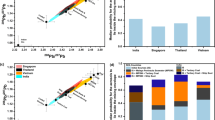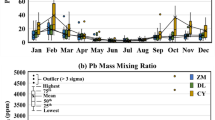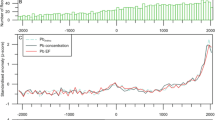Abstract
Lead emitted into the environment (primarily by gasoline combustion and industrial processes) retains the isotopic composition of the ore from which it was derived. Therefore, there is the potential to distinguish sources of lead pollution in the atmosphere by examining the lead isotope ratios1–4. Such a tracer of atmospheric lead would be valuable in air pollution transport studies, as the relatively long residence time of lead aerosols (∼5–10 days), can result in its dispersal over thousands of kilometres. In practice, the situation is complicated by the wide, and frequently changing, variety of ore types used in gasoline additives and in smelting activities5,6. This approach has generally only been successful in identifying local sources of pollution7–9, except where gasoline lead compositions have been deliberately altered10. We have discovered that the lead isotopic composition of atmospheric particu-late matter in the eastern United States is distinctly different from that in eastern Canada, and that the composition is sufficiently constant between sites in each country over periods of several months to allow characteristic isotope ratios to be defined for each. This offers a new approach to examining transboundary pollution between the United States and Canada.
This is a preview of subscription content, access via your institution
Access options
Subscribe to this journal
Receive 51 print issues and online access
$199.00 per year
only $3.90 per issue
Buy this article
- Purchase on Springer Link
- Instant access to full article PDF
Prices may be subject to local taxes which are calculated during checkout
Similar content being viewed by others
References
Chow, T. J. & Johnstone, M. S. Science 147, 502–503 (1965).
Chow, T. J. Proc. 2nd Int. Clean Air Congr. 348–352 (Academic, New York, 1970).
Chow, T. J. & Earl, J. L. Science 176, 510–511 (1972).
Settle, D. M. & Patterson, C. C. J. geophys. Res. 87, 8857–8869 (1982).
Parkinson, G. S. & Catchpole, W. M. J. Inst. Petrol. 59, 59–65 (1973).
Manton, W. I. Arch. Environ. Health 32, 149–159 (1977).
Landrigan, P. J., Baker, Jr, E. L., Earl, J. L. & Chow, J. Proc. 2nd Int. Conf. Stable Isotopes (Oak Brook, Illinois, 1975).
Ault, W. U., Senechal, R. G. & Erlebach, W. E. Environ. Sci. Technol. 4, 305–313 (1970).
Rabinowitz, M. B. & Wetherill, G. W. Environ. Sci. Technol. 6, 705–709 (1972).
Facchetti, S. et al. Commission European Communities Rep. EUR 8352 EN (EEC, Brussels, 1984).
Brown, J. S. Econ. Geol. 57, 673–720 (1962).
Lead In The Canadian Environment: Science and Regulation, Final Report of the Commission of Lead in the Environment (Royal Society of Canada, Ottawa, 1986).
Harrison, R. M. & Sturges, W. T. Atmos. Environ. 17, 311–328 (1983).
Sturges, W. T. & Harrison, R. M. Atmos. Environ. 20, 577–588 (1986).
Barrie, L. A. J. geophys. Res. (in the press).
Sturges, W. T. & Barrie, L. A. Atmos Environ. (in the press).
Sturges, W. T. & Barrie, L. A. Proc. Fourth Symp. On Arctic Air Chemistry (Hurdall, Norway, 1987).
Author information
Authors and Affiliations
Rights and permissions
About this article
Cite this article
Sturges, W., Barrie, L. Lead 206/207 isotope ratios in the atmosphere of North America as tracers of US and Canadian emissions. Nature 329, 144–146 (1987). https://doi.org/10.1038/329144a0
Received:
Accepted:
Issue Date:
DOI: https://doi.org/10.1038/329144a0
This article is cited by
-
A lingering legacy of leaded gasoline in Southeast Asia
Communications Earth & Environment (2023)
-
Unraveling the source(s) and fate of Pb in urban soils and sediments of Ibadan metropolis using lead isotopes
Environmental Geochemistry and Health (2023)
-
Monsoon climate controls metal loading in global hotspot region of transboundary air pollution
Scientific Reports (2022)
-
Spatial distribution of heavy metals and sources of soil contamination in southern Konya (Turkey): Insights from geochemistry, Pb and Sr–Nd isotope systematics
Environmental Earth Sciences (2022)
-
Lead contamination and isotopic composition of the bulk and < 2.5 μm fraction of soils in Xuzhou, China
Environmental Earth Sciences (2021)
Comments
By submitting a comment you agree to abide by our Terms and Community Guidelines. If you find something abusive or that does not comply with our terms or guidelines please flag it as inappropriate.



